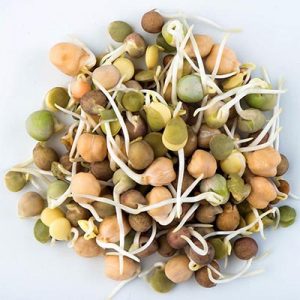Growing some delicious and nutrient-dense sprouts or microgreens is a great indoor gardening project in the wintertime. A wide range of sprouts do not require soil, and they are eaten whole. Alfalfa, beans, and peas are prime candidates for sprouting. Even though sprouts are low in calories, they contain a high percentage of nutrients and beneficial plant compounds.
Sprouting microgreens into thin layers of soil requires only using fresh tops. This method works well with a whole host of garden seeds like broccoli, cabbage, sunflowers, coral, and cilantro.
For microgreens and sprouts, only use organic, untreated seed. Avoid seeds that have been treated with fungicides and pesticides.
No matter whether you grow sprouts or microgreens, don’t eat sprouted tomatoes, peppers, eggplants, and other crops around them as they can be toxic.
Sprouting Seeds
 By sprouting, plant enzymes are activated to complement the pancreatic enzymes produced by the body. Some of the essential amino acids in sprouts can be up to 30% more concentrated with a higher amount of specific amino acids. The ratio of soluble fiber increases by as much as 30% during sprouting and can reduce insoluble fiber by as much as 50%.
By sprouting, plant enzymes are activated to complement the pancreatic enzymes produced by the body. Some of the essential amino acids in sprouts can be up to 30% more concentrated with a higher amount of specific amino acids. The ratio of soluble fiber increases by as much as 30% during sprouting and can reduce insoluble fiber by as much as 50%.
The sprouting process is a simple process and doesn’t need any special equipment. Sprout beans, peas, onions, and radishes in an airtight container like a wide-mouth mason jar that has been well-suspended. Rinse well in clean water several times to remove any debris that floats to the surface.
- The germination process begins with seeds sitting in lukewarm water overnight.
- The seeds should be rinsed until the water is clear. Then drain.
- Put the sprout seeds back into the jar.
- A breathable cloth should be placed over the mouth of the jar’s cap, and the jar lid must be screwed on securely.
- Turn the jar so that it is on its side.
- The seed sprouts should be rinsed and drained three to four times on a regular basis.
- About four days after that, the fresh sprouts are ready for consumption.
Safety Tip: Before consuming raw sprouts, always cook them to avoid the risk of food poisoning or any foodborne illness. Raw sprouts should be avoided by children, pregnant women, the elderly, and people with weak immune systems.
Toss anything with an unpleasant smell — one that indicates mold or bacterial growth — if you can find it.
It should be noted that we are not sprouting any type of kidney beans that contains potentially toxic compounds and requires cooking before consumption.
Growing Microgreens
A microgreen can appear small but it has a variety of health benefits – packed with essential vitamins, bio-available nutrients, amino acids, and a tasty punch. A microgreen contains about five times more vitamins gram for gram than it would if grown to a mature plant.
Simply put, a microgreen is a young vegetable plant that is harvested when it’s young. The growth process is about 10 days or two weeks before the first set of true leaves. Be sure to cut off the vegetative segments just above the root zone.
Following are some popular varieties to grow as microgreens:
Radishes
Radishes are one of the fastest-growing microgreens and are usually harvested 10 to 12 days after sowing. Japanese Daikon, Sango, and Triton are some popular varieties for their bright leaf and stem colors.
Peas
Soak seeds for 8 to 10 hours in warm or cool water before planting them for delicate, sweet, pea-flavored shoots. You can add them to salads, sandwiches, soups, and more. Plant within 10 and 12 days of sowing. Cooking tip: Let the pea microgreens grow for several days, and harvest them as “pea shoots” by cutting them above ground level. Flash cook in a stir-fry.
Swiss Chard
Its leaves look similar to beet greens and the best color variety is by far Rainbow. Swiss chard should only be grown in soil, however, as it doesn’t like to be hydroponic. Harvest between 12 hours to 14 days after planting.
Mustards
If you prefer an entree time of 14 to 16 days, try mustard microgreens for their flavor or a colorful plate, you can pick green mustard varieties or pick red mustard varieties. Harvest within 14 days.
Beet Greens
It is a pleasure to grow beet greens with their crisp flavor and spinach-like bite. Varieties like Bull’s Blood and Detroit Dark Red are popular ones. Soak the seeds for 8 to 10 hours before planting. It is ready to harvest after around 18 days.
Microgreens: How to Grow Them
- Consider using seed-starting trays, disposable pie plates, plastic take-out dishes, or clear salad boxes.
- Put a few drainage holes in the bottom. Set on plastic trays or cookie sheets to prevent spills.
- Sprinkle seeds on the potting soil. Sprinkle seeds lightly on top of the soil, gently press them down and water lightly. Make sure your seeds have not been buried.
- Under grow lights or on a sunny windowsill, keep plants moist.
- Microgreen tops can be harvested by cutting them with scissors as soon as they reach 2 inches or longer. Wash sprout tops gently in a strainer and store in a plastic bag in the refrigerator for up to 5 days.
- It is possible to harvest microgreens for up to three weeks

